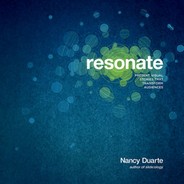Book Description
Product Description
Presentations are meant to inform, inspire, and persuade audiences. So why then do so many audiences leave feeling like they've wasted their time? All too often, presentations don't resonate with the audience and move them to transformative action.
Just as the author's first book helped presenters become visual communicators, Resonate helps you make a strong connection with your audience and lead them to purposeful action. The author's approach is simple: building a presentation today is a bit like writing a documentary. Using this approach, you'll convey your content with passion, persuasion, and impact.
Author has a proven track record, including having created the slides in Al Gore's Oscar-winning An Inconvenient Truth
Focuses on content development methodologies that are not only fundamental but will move people to action
Upends the usual paradigm by making the audience the hero and the presenter the mentor
Shows how to use story techniques of conflict and resolution
Presentations don't have to be boring ordeals. You can make them fun, exciting, and full of meaning. Leave your audiences energized and ready to take action with Resonate.
Table of Contents
- Resonate: Present Visual Stories that Transform Audiences
- Copyright
- Dedication
- Acknowledgments
- Contents
- Foreword
- Introduction
- Chapter 1: Why Resonate?
- Chapter 2: Lessons from Myths and Movies
- Incorporate Story
- Drama Is Everything
- Story Templates Create Structure
- The Hero’s Journey Structure
- Crossing the Threshold
- The Contour of Communication
- The Beginning and Call to Adventure
- The Middle: Contrast
- Call to Action
- The End
- What Is a Sparkline?
- Case Study: Benjamin Zander
- Zander’s Sparkline
- RULE #2: Incorporating story into presentations has an exponential effect on outcomes.
- Chapter 3: Get to Know the Hero
- Chapter 4: Define the Journey
- Chapter 5: Create Meaningful Content
- Everything and the Kitchen Sink
- More Than Just Facts
- Don’t Be So Cerebral
- Contrast Creates Contour
- Transform Ideas Into Meaning
- Recall Stories
- Turn Information Into Stories
- Case Study: Cisco Systems
- Move from Data to Meaning
- Murder Your Darlings
- From Ideas to Messages
- RULE #5: Use the big idea to filter out all frequencies other than the resonant frequency.
- Chapter 6: Structure Reveals Insights
- Chapter 7: Deliver Something They’ll Always Remember
- Create a S.T.A.R. Moment
- Case Study: Michael Pollan
- Repeatable Sound Bites
- Evocative Visuals
- Case Study: Pastor John Ortberg
- Ortberg’s Sparkline
- Case Study: Rauch Foundation
- Case Study: Steve Jobs
- Jobs’s Sparkline
- RULE #7: Memorable moments are repeated and retransmitted so they cover longer distances.
- Chapter 8: There’s Always Room to Improve
- Amplify the Signal, Minimize the Noise
- Give a Positive First Impression
- Hop Down from Your Tower
- Value Brevity
- Wean Yourself from the Slides
- Balance Emotion
- Host a Screening with Honest Critics
- Case Study: Markus Covert, PhD
- Case Study: Leonard Bernstein
- RULE #8: Audience interest is directly proportionate to the presenter’s preparation.
- Chapter 9: Change Your World
- Changing the World Is Hard
- Use Presentations to Help Change the World
- Don’t Use Presentations for Evil
- Enron’s Presentations During Implosion
- Gain Competitive Advantage
- Case Study: Martin Luther King Jr. (1/2)
- Case Study: Martin Luther King Jr. (2/2)
- Case Study: Martha Graham
- Be Transparent So People See Your Idea
- You Can Transform Your World
- Inspiration Is Everywhere
- References
- Picture Credits
- Index (1/2)
- Index (2/2)
- Special Thanks
